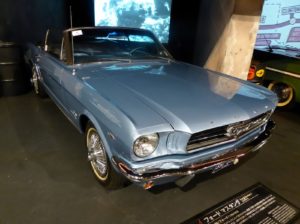If April 16, 1972, was a day on which Panda-Monium broke out in the U.S. because of the appearance of giant pandas, April 17 was a day of pandemonium for another kind of beast—the Ford Mustang.
The 1964 ½ Ford Mustang could be purchased for the first time on April 17, 1964. Car fans awaited the day with great anticipation. Simultaneous ads ran on April 16 on the three major television networks, and the car was officially introduced at the New York World’s Fair. Although we think of it as being named after a wild horse, the name actually comes from the World War II “Mustang” fighter plane.
The Ford Mustang was the “working man’s Thunderbird,” a sports car that could seat four and cost a modest $2300. It could be plain and minimally powered, using parts re-tooled from the economy Ford Falcon, or it could be souped up in style and power. A buying frenzy broke out on April 17—22,000 Mustangs were bought on that one day. More than 400,000 were bought in the first year, and more than 9 million have been bought since then.

A friend during my freshman year at the University of Illinois in 1966 brought his Mustang down to school one weekend (freshmen couldn’t have cars on campus in those days). He let me drive the cherry red convertible around campus. Heads turned as I cruised up and down Green Street, and for the one and only time I felt like the BMOC.
And that’s the way Americans have always felt about their cars. When I speak around the country about the BP oil spill, I tell audiences that the cause of the spill wasn’t the greed or disregard of the oil companies. No, it is American addiction to oil. We love our cars and, so, we have organized our society around driving the wonderful, beautiful things. Around the neighborhood, around town, around the country. From gas station to gas station.
Consequently, America—along with Canada, which also loves its cars—uses more oil than anywhere in the world. With 4.5% of the world’s population, the U.S. uses 20% of the world’s petroleum. With about 18% of the world’s population, China uses about 12% of its petroleum. On a per person basis, the U.S. uses about 12 gallons per person per day, while China uses about 2 gallons per person per day—so, each American uses 6 times more petroleum each day to get by than a Chinese person does.
And where do we get that fuel for our cars? From everywhere is the answer. The U.S. produces about 80% of the oil we consume, a recent turn-around from decades of large and increasing oil imports. That percentage of domestic production—the highest since 1964—has grown recently with technologies that allow the exploitation of so-called “tight oil” (technologies like fracking, horizontal drilling and seismic imaging). The U.S. imports the remainder from 84 different countries. Most comes from Canada (40%), Saudia Arabia (9%), Mexico (9%), Venezuela (7%) and Iraq (6%).
Oil consumption in the U.S. peaked in 2004, after a rising trend that has lasted, except for short disruptions, since oil became widely available at the start of the 20th Century. Projections used to anticipate much higher oil consumption, but now projections suggest a stable consumption well into the future. The lack of increasing consumption has occurred for two reasons. First, people are driving less—vehicle miles traveled has declined, because fuel prices have risen and because the baby-boomers are driving less. Second, rising fuel economy—getting more miles per gallon—has made driving more efficient.
So, there is good news for our oil addiction. We seem to be laying off the sauce, at least a little bit. If we keep it going, perhaps we might just have a chance to save the atmosphere and assure a sustainable planet.
And if we can convert all those classic Ford Mustangs into electric cars, what a wonderful world it will be!
References:
Classic Pony Cars. History of the Ford Mustang. Available at: http://classicponycars.com/history.html. Accessed April 16, 2018.
Cox, Lydia. 2015. The surprising decline in US petroleum consumption. World Economic Forum, 10 Jul 2015. Available at: https://www.weforum.org/agenda/2015/07/the-surprising-decline-in-us-petroleum-consumption/. Accessed April 16, 2018.
Energy Information Administration. How much oil consumed by the United States comes from foreign countries? Available at: https://www.eia.gov/tools/faqs/faq.php?id=32&t=6. Accessed April 16, 2018.
History.com. Ford Mustang debuts at World’s Fair. This Day In History, April 17. Available at: https://www.history.com/this-day-in-history/ford-mustang-debuts-at-worlds-fair. Accessed April 16, 2018.
